Using a Remote-Sensing-Based Piecewise Retrieval Algorithm to Map Chlorophyll-a Concentration in a Highland River System
Abstract
1. Introduction
2. Materials and Methods
2.1. Study Area
2.2. Data
2.2.1. Field Spectral Data Measurement and Water Sample Collection
2.2.2. Remote-Sensing Data
2.2.3. Meteorological Data
2.3. Methods
2.3.1. The Validation of the Classical Models
2.3.2. Spectral Index Based Regression Model
2.3.3. Model Optimization Based on Spectral Index
2.3.4. Model Metrics
3. Results
3.1. Piecewise Model Building
3.2. Spatial and Temporal Distribution of Chl-a Concentration
4. Discussion
4.1. Comparison of Model Accuracy
4.2. Influencing Factors of Chl-a Concentration Change
5. Conclusions
- (1)
- Although spectral normalization can distinctly eliminate environmental noise and enhance the correlation between remote-sensing reflectance and chl-a concentration, the models based on spectral normalization did not have a higher performance that the models based on the initially calculated reflectance. This means that the original reflectance could be used to build chl-a models.
- (2)
- According to the performance of various algorithms after optimization, it is difficult to capture the total change in chl-a concentration using only a single algorithm in water bodies with complex conditions. Although some semi-analytical algorithms, such as G2B, D3B and L4B, had higher accuracy for all types of water bodies, with an average relative error within 20%, their prediction accuracy in water bodies with a low chl-a concentration (≤4.50 mg/m3) was obviously lower than in water bodies with high chl-a concentration. Therefore, a more reliable framework is needed to improve the modelling results.
- (3)
- The spectral sensitivity analyses showed that the water bodies could be divided into two types (>4.50 mg/m3 and ≤4.50 mg/m3) when the three-band reflectance variable D3B was −0.051. Finally, we constructed an integrated piecewise model to more accurately map chl-a concentration. The modelling results indicated that our piecewise model has a better performance in all types of water bodies (R2 = 0.96, RMSE = 0.32 mg/m3, MAE = 0.24 mg/m3, MRE = 5.71%).
- (4)
- The chl-a concentration in our study area had a seasonal pattern. The concentration in summer is the highest, followed by spring and autumn, and the lowest in winter. The chl-a concentration in small ponds and riparian wetlands was higher than that in rivers. The correlation between meteorological variables showed that temperature was probably the main driver for variations in chl-a concentration.
Author Contributions
Funding
Data Availability Statement
Conflicts of Interest
References
- Babin, M.; Morel, A.; Gentili, B. Remote sensing of sea surface Sun-induced chlorophyll fluorescence: Consequences of natural variations in the optical characteristics of phytoplankton and the quantum yield of chlorophyll a fluorescence. Int. J. Remote Sens. 1996, 17, 2417–2448. [Google Scholar] [CrossRef]
- O’Reilly, J.E.; Maritorena, S.; Mitchell, B.G.; Siegel, D.A.; Carder, K.L.; Garver, S.A.; Kahru, M.; McClain, C. Ocean color chlorophyll algorithms for SeaWiFS. J. Geophys. Res. Ocean. 1998, 103, 24937–24953. [Google Scholar] [CrossRef]
- Ali, K.A.; Ortiz, J.; Bonini, N.; Shuman, M.; Sydow, C. Application of Aqua MODIS sensor data for estimating chlorophyll a in the turbid Case 2 waters of Lake Erie using bio-optical models. GISci. Remote Sens. 2016, 53, 483–505. [Google Scholar] [CrossRef]
- Watanabe, F.S.; Alcântara, E.; Rodrigues, T.W.; Imai, N.N.; Barbosa, C.C.; Rotta, L.H. Estimation of Chl-a Concentration and the Trophic State of the Barra Bonita Hydroelectric Reservoir Using OLI/Landsat-8 Images. Int. J. Environ. Res. Public Health 2015, 12, 10391–10417. [Google Scholar] [CrossRef]
- Gurlin, D.; Gitelson, A.A.; Moses, W.J. Remote estimation of chl-a concentration in turbid productive waters—Return to a simple two-band NIR-red model? Remote Sens. Environ. 2011, 115, 3479–3490. [Google Scholar] [CrossRef]
- Smith, M.E.; Lain, L.R.; Bernard, S. An optimized Chlorophyll a switching algorithm for MERIS and OLCI in phytoplankton-dominated waters. Remote Sens. Environ. 2018, 215, 217–227. [Google Scholar] [CrossRef]
- Tassan, S. Local Algorithms Using Seawifs Data for the Retrieval of Phytoplankton, Pigments, Suspended Sediment, and Yellow Substance in Coastal Waters. Appl. Opt. 1994, 33, 2369–2378. [Google Scholar] [CrossRef]
- Koponen, S.; Attila, J.; Pulliainen, J.; Kallio, K.; Pyhalahti, T.; Lindfors, A.; Rasmus, K.; Hallikainen, M. A case study of airborne and satellite remote sensing of a spring bloom event in the Gulf of Finland. Cont. Shelf Res. 2007, 27, 228–244. [Google Scholar] [CrossRef]
- Le, C.F.; Hu, C.M.; Cannizzaro, J.; English, D.; Muller-Karger, F.; Lee, Z. Evaluation of chl-a remote sensing algorithms for an optically complex estuary. Remote Sens. Environ. 2013, 129, 75–89. [Google Scholar] [CrossRef]
- Zhang, Y.; Shi, K.; Cao, Z.; Lai, L.; Geng, J.; Yu, K.; Zhan, P.; Liu, Z. Effects of satellite temporal resolutions on the remote derivation of trends in phytoplankton blooms in inland waters. ISPRS J. Photogramm. Remote Sens. 2022, 191, 188–202. [Google Scholar] [CrossRef]
- Wenxiang, D.; Caiyun, Z.; Shaoping, S.; Xueding, L. Optimization of deep learning model for coastal chlorophyll a dynamic forecast. Ecol. Model. 2022, 467, 109913. [Google Scholar] [CrossRef]
- Tong, Y.; Feng, L.; Zhao, D.; Xu, W.; Zheng, C. Remote sensing of chl-a concentrations in coastal oceans of the Greater Bay Area in China: Algorithm development and long-term changes. Int. J. Appl. Earth Obs. Geoinf. 2022, 112, 102922. [Google Scholar] [CrossRef]
- Qin, J.; Meng, Z.; Xu, W.; Li, B.; Cheng, X.; Murtugudde, R. Modulation of the Intraseasonal Chlorophyll-a Concentration in the Tropical Indian Ocean by the Central Indian Ocean Mode. Geophys. Res. Lett. 2022, 49, e2022GL097802. [Google Scholar] [CrossRef]
- Liu, H.; He, B.; Zhou, Y.; Kutser, T.; Toming, K.; Feng, Q.; Yang, X.; Fu, C.; Yang, F.; Li, W.; et al. Trophic state assessment of optically diverse lakes using Sentinel-3-derived trophic level index. Int. J. Appl. Earth Obs. Geoinf. 2022, 114, 103026. [Google Scholar] [CrossRef]
- Legleiter, C.J.; King, T.V.; Carpenter, K.D.; Hall, N.C.; Mumford, A.C.; Slonecker, T.; Graham, J.L.; Stengel, V.G.; Simon, N.; Rosen, B.H. Spectral mixture analysis for surveillance of harmful algal blooms (SMASH): A field-, laboratory-, and satellite-based approach to identifying cyanobacteria genera from remotely sensed data. Remote Sens. Environ. 2022, 279, 113089. [Google Scholar] [CrossRef]
- Kayastha, P.; Dzialowski, A.R.; Stoodley, S.H.; Wagner, K.L.; Mansaray, A.S. Effect of Time Window on Satellite and Ground-Based Data for Estimating Chl-a in Reservoirs. Remote Sens. 2022, 14, 846. [Google Scholar] [CrossRef]
- Hu, M.; Ma, R.; Xiong, J.; Wang, M.; Cao, Z.; Xue, K. Eutrophication state in the Eastern China based on Landsat 35-year observations. Remote Sens. Environ. 2022, 277, 113057. [Google Scholar] [CrossRef]
- Mehrtens, H.; Martin, T. Remote sensing of oligotrophic waters: Model divergence at low chlorophyll concentrations. Appl. Opt. 2002, 41, 7058–7067. [Google Scholar] [CrossRef]
- Zhang, K.X.; Li, W.; Eide, H.; Stamnes, K. A bio-optical model suitable for use in forward and inverse coupled atmosphere-ocean radiative transfer models. J. Quant. Spectrosc. Radiat. Transf. 2007, 103, 411–423. [Google Scholar] [CrossRef]
- Cao, Y.N.; Li, X.H.; Ma, S.D.; Ai, J.Y.; Zhu, H.X. Urban Water Absorbance to Predict Chlorophyll a and Turbidity. Aer. Adv. Eng. Res. 2018, 174, 165–172. [Google Scholar] [CrossRef][Green Version]
- Yussof, F.N.; Maan, N.; Reba, M.N.M. LSTM Networks to Improve the Prediction of Harmful Algal Blooms in the West Coast of Sabah. Int. J. Environ. Res. Public Health 2021, 18, 7650. [Google Scholar] [CrossRef] [PubMed]
- Gitelson, A.; Keydan, G.; Shishkin, V. Inland waters quality assessment from satellite data in visible range of the spectrum. Sov. Remote Sens. 1985, 6, 28–36. [Google Scholar]
- Dall’Olmo, G.; Gitelson, A.A. Effect of bio-optical parameter variability and uncertainties in reflectance measurements on the remote estimation of chl-a concentration in turbid productive waters: Modeling results. Appl. Opt. 2006, 45, 3577–3592. [Google Scholar] [CrossRef] [PubMed]
- Tang, C.; Wu, Y.; Huang, J. Band Selection of Hyperspectral Chl-a Concentration Inversion Based on Parallel Ant Colony Algorithm. Appl. Mech. Mater. 2014, 675–677, 1158–1162. [Google Scholar] [CrossRef]
- Dall’Olmo, G.; Gitelson, A.A. Effect of bio-optical parameter variability on the remote estimation of chl-a concentration in turbid productive waters: Experimental results. Appl. Opt. 2005, 44, 412–422. [Google Scholar] [CrossRef]
- Le, C.F.; Li, Y.M.; Zha, Y.; Sun, D.Y.; Huang, C.C.; Lu, H. A four-band semi-analytical model for estimating chlorophyll a in highly turbid lakes: The case of Taihu Lake, China. Remote Sens. Environ. 2009, 113, 1175–1182. [Google Scholar] [CrossRef]
- El-Alem, A.; Chokmani, K.; Laurion, I.; El-Adlouni, S.E. Comparative Analysis of Four Models to Estimate Chl-a Concentration in Case-2 Waters Using MODerate Resolution Imaging Spectroradiometer (MODIS) Imagery. Remote Sens. 2012, 4, 2373–2400. [Google Scholar] [CrossRef]
- Gower, J.F.R.; Doerffer, R.; Borstad, G.A. Interpretation of the 685nm peak in water-leaving radiance spectra in terms of fluorescence, absorption and scattering, and its observation by MERIS. Int. J. Remote Sens. 2010, 20, 1771–1786. [Google Scholar] [CrossRef]
- Gower, J.; King, S.; Borstad, G.; Brown, L. Detection of intense plankton blooms using the 709 nm band of the MERIS imaging spectrometer. Int. J. Remote Sens. 2005, 26, 2005–2012. [Google Scholar] [CrossRef]
- Shen, F.; Zhou, Y.X.; Li, D.J.; Zhu, W.J.; Salama, M.S. Medium resolution imaging spectrometer (MERIS) estimation of chl-a concentration in the turbid sediment-laden waters of the Changjiang (Yangtze) Estuary. Int. J. Remote Sens. 2010, 31, 4635–4650. [Google Scholar] [CrossRef]
- Woo Kim, Y.; Kim, T.; Shin, J.; Lee, D.-S.; Park, Y.-S.; Kim, Y.; Cha, Y. Validity evaluation of a machine-learning model for chlorophyll a retrieval using Sentinel-2 from inland and coastal waters. Ecol. Indic. 2022, 137, 108737. [Google Scholar] [CrossRef]
- Li, Z.; Yang, W.; Matsushita, B.; Kondoh, A. Remote estimation of phytoplankton primary production in clear to turbid waters by integrating a semi-analytical model with a machine learning algorithm. Remote Sens. Environ. 2022, 275, 113027. [Google Scholar] [CrossRef]
- Chusnah, W.N.; Chu, H.-J. Estimating chl-a concentrations in tropical reservoirs from band-ratio machine learning models. Remote Sens. Appl. Soc. Environ. 2022, 25, 100678. [Google Scholar] [CrossRef]
- Cao, Z.; Ma, R.; Liu, M.; Duan, H.; Xiao, Q.; Xue, K.; Shen, M. Harmonized Chl-a Retrievals in Inland Lakes From Landsat-8/9 and Sentinel 2A/B Virtual Constellation Through Machine Learning. IEEE Trans. Geosci. Remote Sens. 2022, 60, 1–16. [Google Scholar] [CrossRef]
- Asim, M.; Brekke, C.; Mahmood, A.; Eltoft, T.; Reigstad, M. Improving Chl-a Estimation From Sentinel-2 (MSI) in the Barents Sea Using Machine Learning. IEEE J. Stars 2021, 14, 5529–5549. [Google Scholar] [CrossRef]
- Pahlevan, N.; Smith, B.; Schalles, J.; Binding, C.; Cao, Z.; Ma, R.; Alikas, K.; Kangro, K.; Gurlin, D.; Hà, N.; et al. Seamless retrievals of chl-a from Sentinel-2 (MSI) and Sentinel-3 (OLCI) in inland and coastal waters: A machine-learning approach. Remote Sens. Environ. 2020, 240, 111604. [Google Scholar] [CrossRef]
- Dekker, A.G.; Brando, V.E.; Anstee, J.M. Retrospective seagrass change detection in a shallow coastal tidal Australian lake. Remote Sens. Environ. 2005, 97, 415–433. [Google Scholar] [CrossRef]
- Gons, H.J.; Auer, M.T.; Effler, S.W. MERIS satellite chlorophyll mapping of oligotrophic and eutrophic waters in the Laurentian Great Lakes. Remote Sens. Environ. 2008, 112, 4098–4106. [Google Scholar] [CrossRef]
- Matsushita, B.; Yang, W.; Yu, G.L.; Oyama, Y.; Yoshimura, K.; Fukushima, T. A hybrid algorithm for estimating the chl-a concentration across different trophic states in Asian inland waters. Isprs J. Photogramm. Remote Sens. 2015, 102, 28–37. [Google Scholar] [CrossRef]
- Zhang, F.F.; Li, J.S.; Shen, Q.; Zhang, B.; Wu, C.Q.; Wu, Y.F.; Wang, G.L.; Wang, S.L.; Lu, Z.Y. Algorithms and Schemes for Chlorophyll a Estimation by Remote Sensing and Optical Classification for Turbid Lake Taihu, China. IEEE J. Stars 2015, 8, 350–364. [Google Scholar] [CrossRef]
- Odermatt, D.; Danne, O.; Philipson, P.; Brockmann, C. Diversity II water quality parameters from ENVISAT (2002-2012): A new global information source for lakes. Earth Syst. Sci. Data 2018, 10, 1527–1549. [Google Scholar] [CrossRef]
- Binding, C.E.; Greenberg, T.A.; Bukata, R.P. The MERIS Maximum Chlorophyll Index; its merits and limitations for inland water algal bloom monitoring. J. Great Lakes Res. 2013, 39, 100–107. [Google Scholar] [CrossRef]
- Gilerson, A.A.; Gitelson, A.A.; Zhou, J.; Gurlin, D.; Moses, W.; Ioannou, I.; Ahmed, S.A. Algorithms for remote estimation of chl-a in coastal and inland waters using red and near infrared bands. Opt. Express 2010, 18, 24109–24125. [Google Scholar] [CrossRef] [PubMed]
- Gons, H.J.; Rijkeboer, M.; Ruddick, K.G. A chlorophyll-retrieval algorithm for satellite imagery (Medium Resolution Imaging Spectrometer) of inland and coastal waters. J. Plankton Res. 2002, 24, 947–951. [Google Scholar] [CrossRef]
- Xu, X.; Wang, X.; Zhu, X.; Jia, H.; Han, D. Landscape Pattern Changes in Alpine Wetland of Bayanbulak Swan Lake during 1996-2015. J. Nat. Resour. 2018, 33, 1897–1911. [Google Scholar] [CrossRef]
- Carlson, R.E. Estimating trophic state. LakeLine 2007, 27, 25–28. [Google Scholar]
- Shen, M.; Wang, S.; Li, Y.; Tang, M.; Ma, Y. Pattern of Turbidity Change in the Middle Reaches of the Yarlung Zangbo River, Southern Tibetan Plateau, from 2007 to 2017. Remote Sens. 2021, 13, 182. [Google Scholar] [CrossRef]
- Knaeps, E.; Doxaran, D.; Dogliotti, A.; Nechad, B.; Ruddick, K.; Raymaekers, D.; Sterckx, S. The SeaSWIR dataset. Earth Syst. Sci. Data 2018, 10, 1439–1449. [Google Scholar] [CrossRef]
- Gitelson, A.A.; Gurlin, D.; Moses, W.J.; Barrow, T. A bio-optical algorithm for the remote estimation of the chl-a concentration in case 2 waters. Environ. Res. Lett. 2009, 4, 045003. [Google Scholar] [CrossRef]
- Qi, L.; Hu, C.M.; Duan, H.T.; Cannizzaro, J.; Ma, R.H. A novel MERIS algorithm to derive cyanobacterial phycocyanin pigment concentrations in a eutrophic lake: Theoretical basis and practical considerations. Remote Sens. Environ. 2014, 154, 298–317. [Google Scholar] [CrossRef]
- Main-Knorn, M.; Pflug, B.; Debaecker, V.; Louis, J. Calibration and Validation Plan for the L2A Processor and Products of the Sentinel-2 Mission. Int. Arch. Photogramm. Remote Sens. Spat. Inf. Sci. 2015, XL-7/W3, 1249–1255. [Google Scholar] [CrossRef]
- Mishra, S.; Mishra, D.R. Normalized difference chlorophyll index: A novel model for remote estimation of chl-a concentration in turbid productive waters. Remote Sens. Environ. 2012, 117, 394–406. [Google Scholar] [CrossRef]
- Reynolds, C.S.; Descy, J.P.; Padisak, J. Are Phytoplankton Dynamics in Rivers So Different from Those in Shallow Lakes. Hydrobiologia 1994, 289, 1–7. [Google Scholar] [CrossRef]
- Carneiro, F.M.; Nabout, J.C.; Vieira, L.C.G.; Roland, F.; Bini, L.M. Determinants of chl-a concentration in tropical reservoirs. Hydrobiologia 2014, 740, 89–99. [Google Scholar] [CrossRef]
- Staehr, P.A.; Baastrup-Spohr, L.; Sand-Jensen, K.; Stedmon, C. Lake metabolism scales with lake morphometry and catchment conditions. Aquat. Sci. 2012, 74, 155–169. [Google Scholar] [CrossRef]


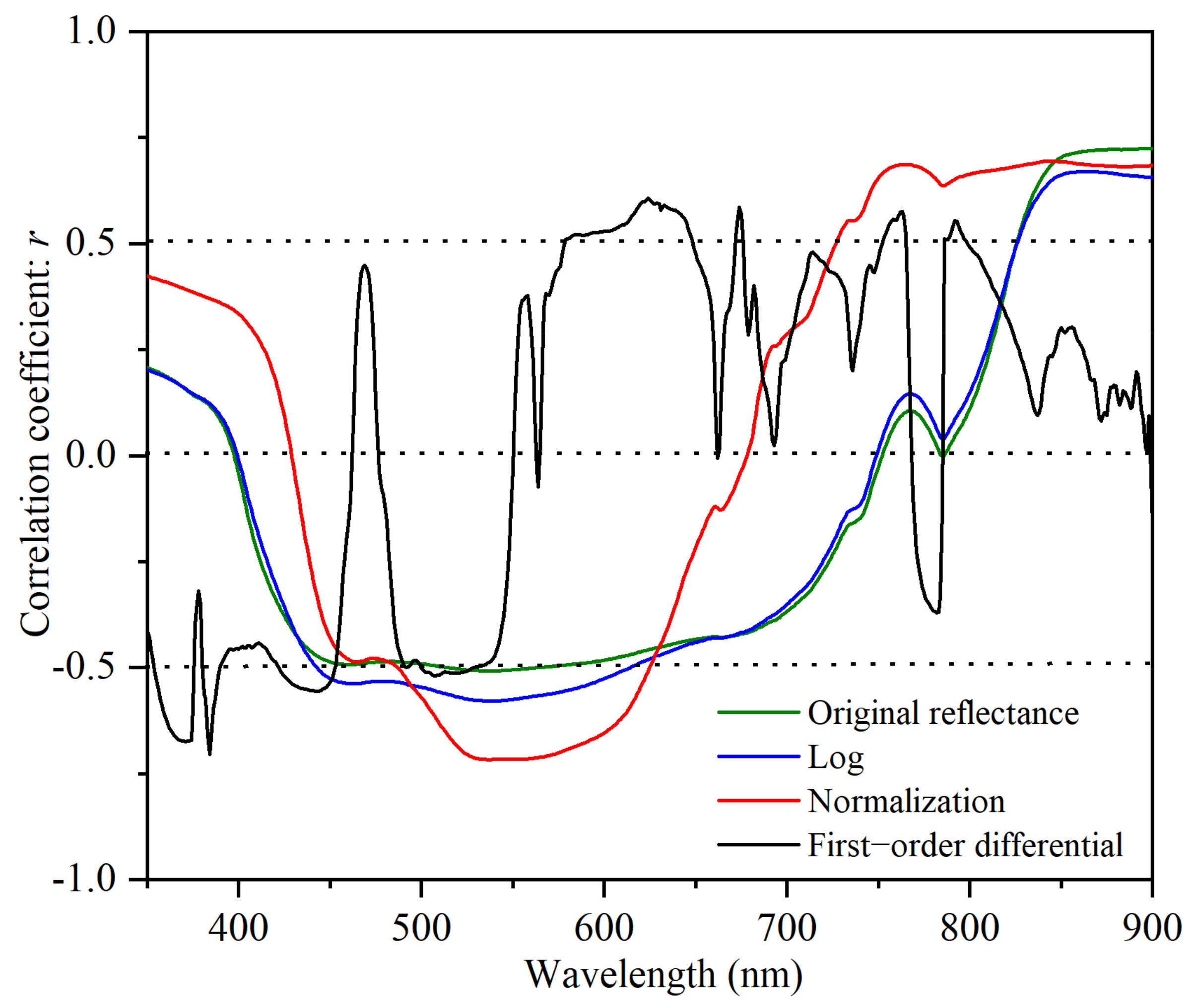
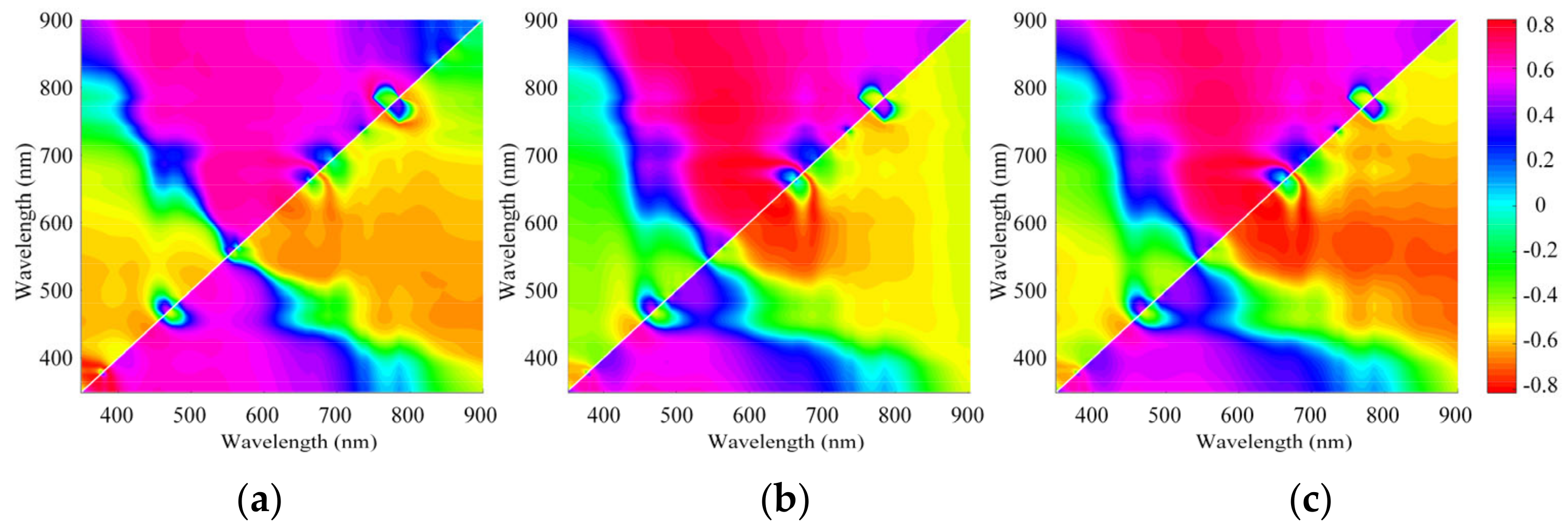


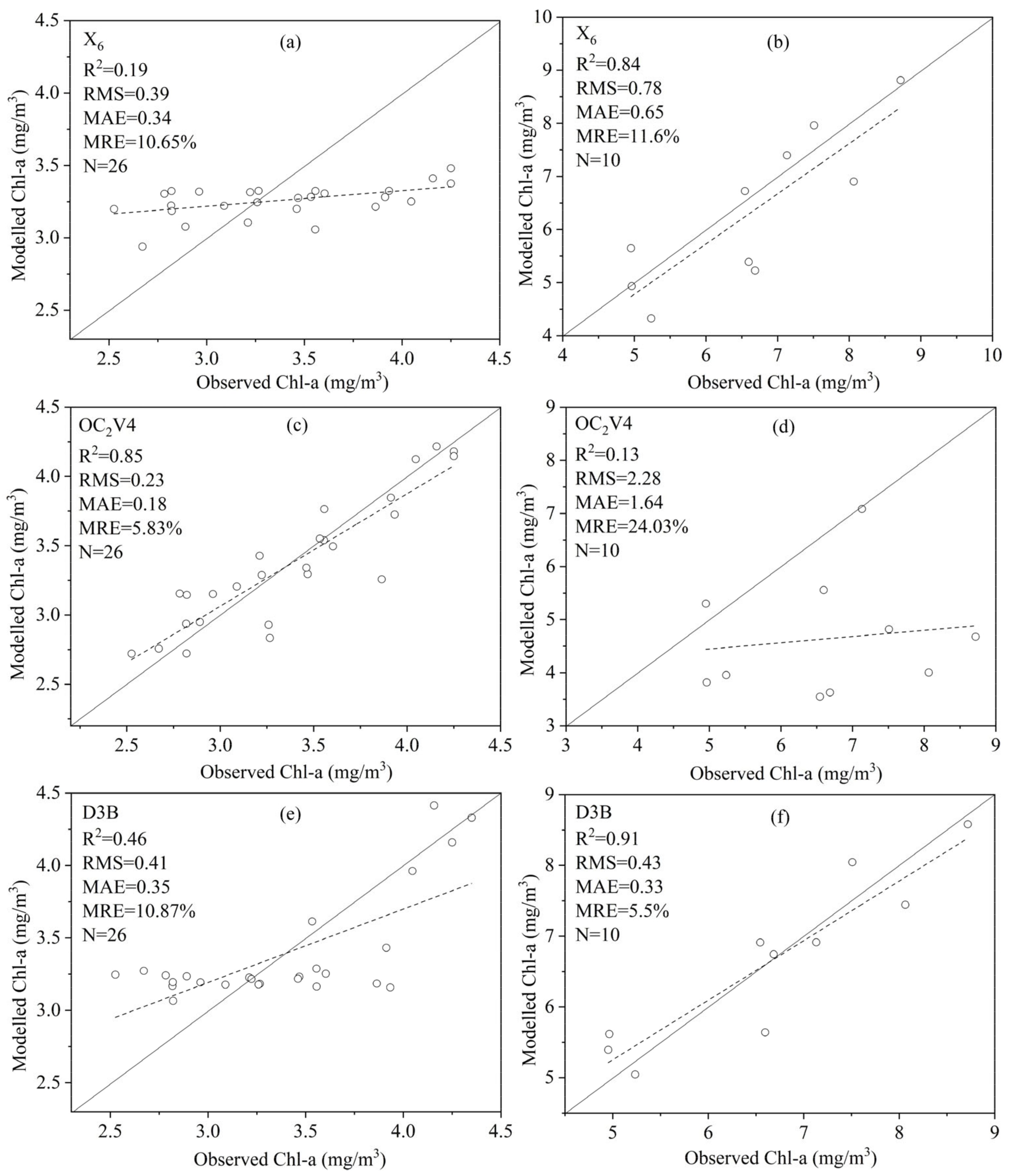

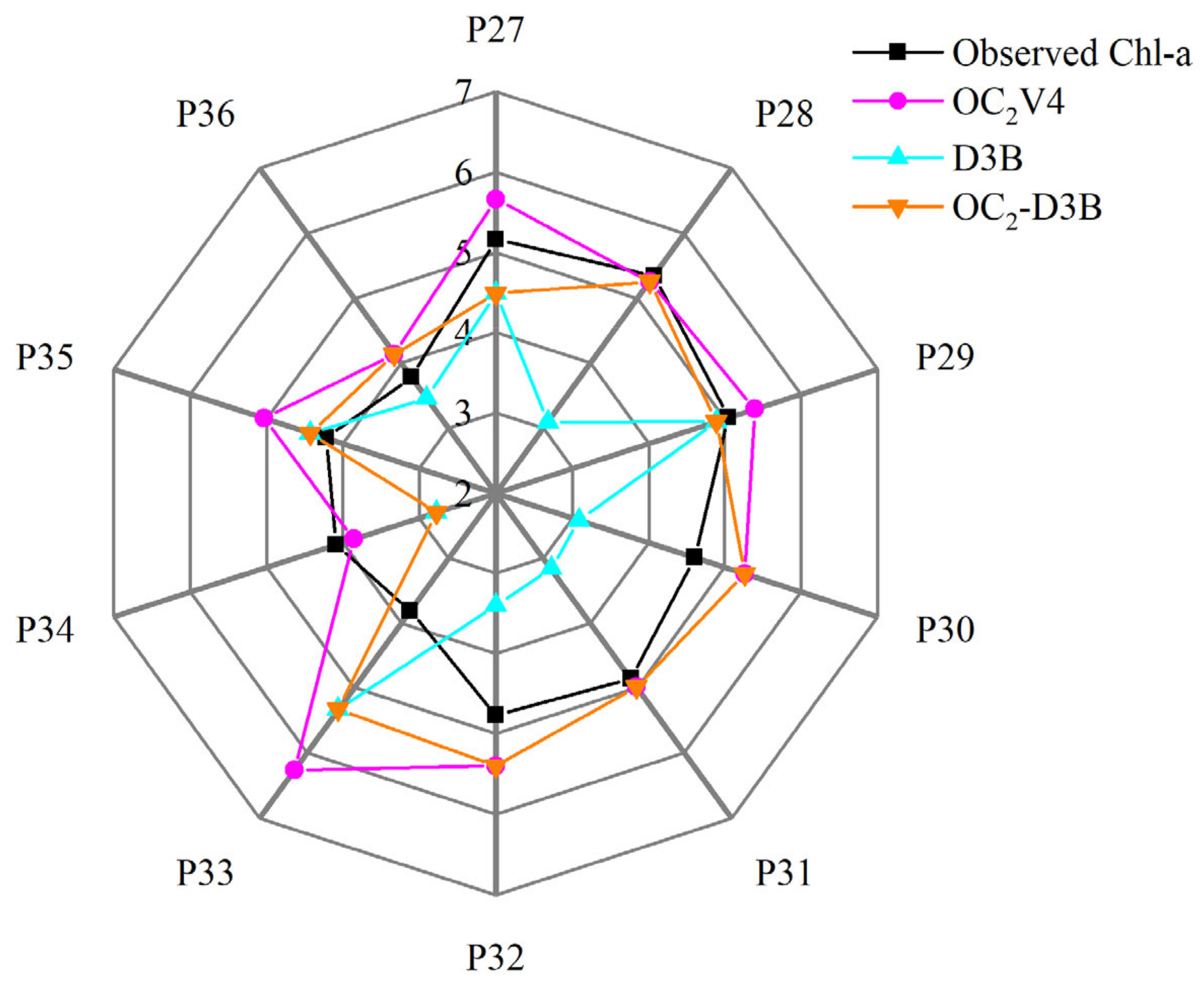

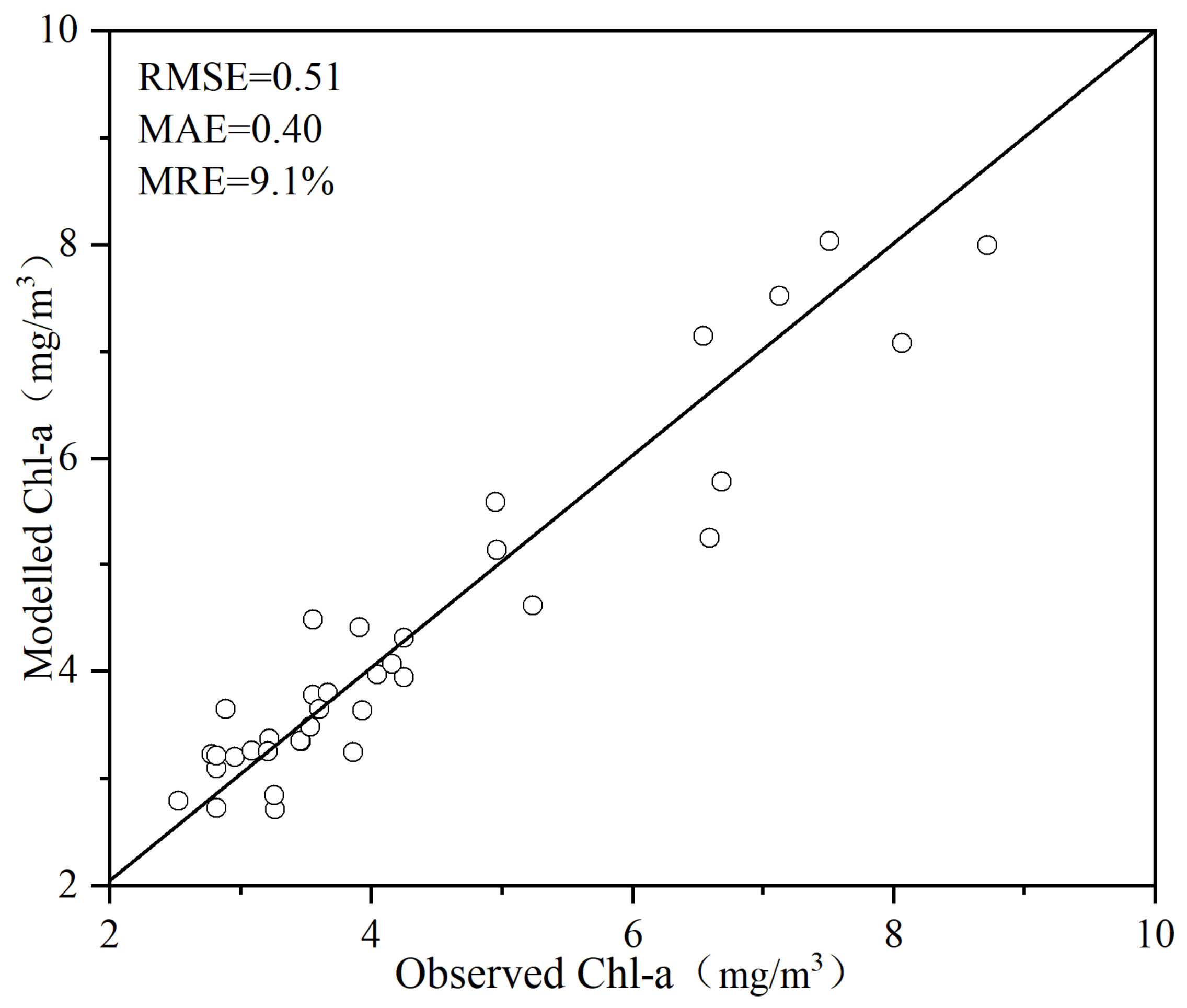
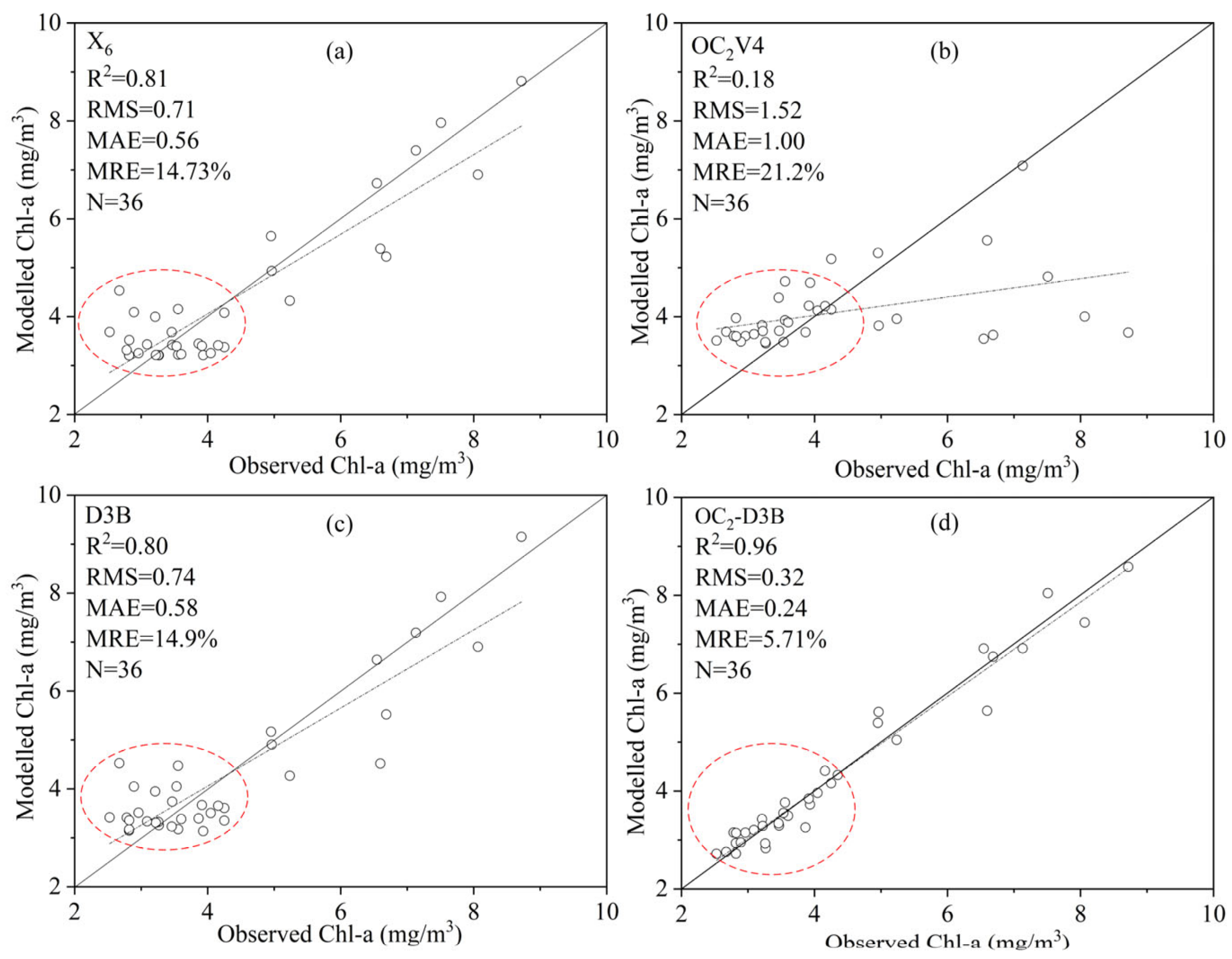
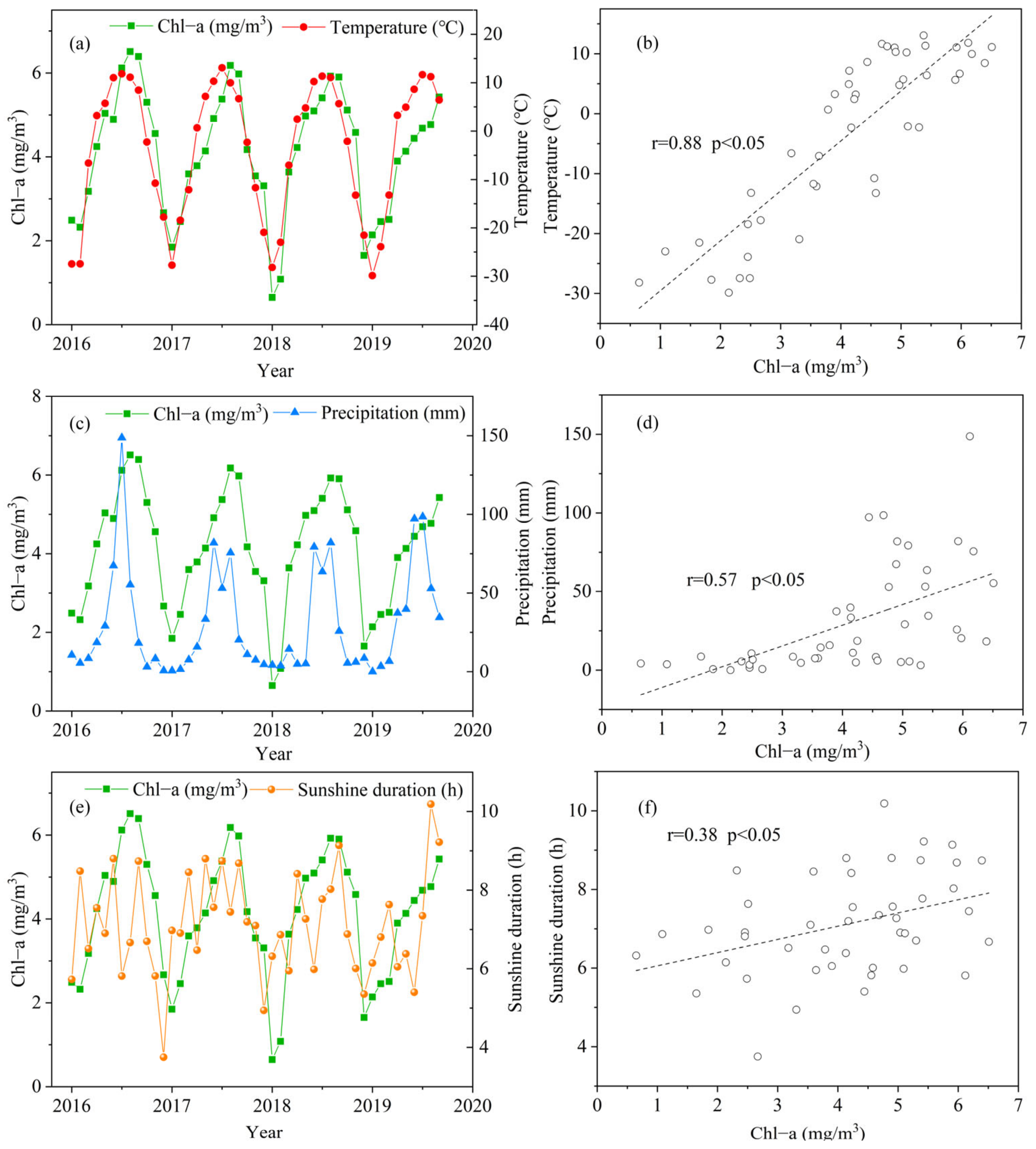
| Samples | Min (mg/m3) | Max (mg/m3) | Mean (mg/m3) | STD (mg/m3) | CV | Number of Samples |
|---|---|---|---|---|---|---|
| Total | 2.53 | 8.72 | 4.29 | 1.65 | 0.39 | 38 |
| Main River | 2.78 | 8.06 | 4.16 | 1.37 | 0.33 | 12 |
| Ponds | 2.53 | 8.72 | 5.33 | 1.98 | 0.37 | 13 |
| Tributaries | 2.67 | 5.24 | 3.37 | 0.67 | 0.20 | 13 |
| Model | Equation |
|---|---|
| Tchl-a [7] | |
| OC2V4 [2] | |
| OC4V4 [2] | |
| NDCI [52] | |
| FLH [28] | |
| MCI [29] | |
| SCI [30] | |
| G2B [22] | |
| D3B [25] | |
| L4B [26] | |
| Gchl-a [44] |
| Model | Variable | Equation | R2 |
|---|---|---|---|
| X1 | 0.56 | ||
| X2 | 0.48 | ||
| X3 | 0.36 | ||
| X4 | 0.34 | ||
| X5 | 0.63 | ||
| X6 | 0.82 | ||
| X7 | 0.73 |
| D3B | chl-a Min. | chl-a Max. | chl-a Mean | STD | CV | Number of samples |
| D3B ≤ −0.051 | 2.53 | 4.25 | 3.40 | 0.50 | 0.15 | 24 |
| D3B > −0.051 | 2.67 | 8.72 | 6.05 | 1.73 | 0.28 | 12 |
| chl-a | Min. | Max. | Mean | SD | CV | Number of samples |
| chl-a ≤ 4.50 mg/m3 | −0.092 | −0.041 | −0.072 | 0.014 | −0.19 | 26 |
| chl-a > 4.50 mg/m3 | −0.047 | 0.026 | −0.014 | 0.023 | −1.69 | 10 |
Publisher’s Note: MDPI stays neutral with regard to jurisdictional claims in published maps and institutional affiliations. |
© 2022 by the authors. Licensee MDPI, Basel, Switzerland. This article is an open access article distributed under the terms and conditions of the Creative Commons Attribution (CC BY) license (https://creativecommons.org/licenses/by/4.0/).
Share and Cite
Ma, Y.; Sun, D.; Liu, W.; You, Y.; Wang, S.; Sun, Z.; Wang, S. Using a Remote-Sensing-Based Piecewise Retrieval Algorithm to Map Chlorophyll-a Concentration in a Highland River System. Remote Sens. 2022, 14, 6119. https://doi.org/10.3390/rs14236119
Ma Y, Sun D, Liu W, You Y, Wang S, Sun Z, Wang S. Using a Remote-Sensing-Based Piecewise Retrieval Algorithm to Map Chlorophyll-a Concentration in a Highland River System. Remote Sensing. 2022; 14(23):6119. https://doi.org/10.3390/rs14236119
Chicago/Turabian StyleMa, Yuanxu, Dongqi Sun, Weihua Liu, Yongfa You, Siyuan Wang, Zhongchang Sun, and Shaohua Wang. 2022. "Using a Remote-Sensing-Based Piecewise Retrieval Algorithm to Map Chlorophyll-a Concentration in a Highland River System" Remote Sensing 14, no. 23: 6119. https://doi.org/10.3390/rs14236119
APA StyleMa, Y., Sun, D., Liu, W., You, Y., Wang, S., Sun, Z., & Wang, S. (2022). Using a Remote-Sensing-Based Piecewise Retrieval Algorithm to Map Chlorophyll-a Concentration in a Highland River System. Remote Sensing, 14(23), 6119. https://doi.org/10.3390/rs14236119












